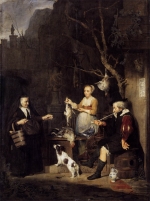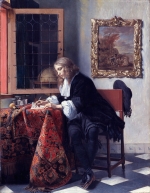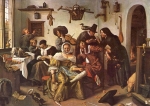Daniel Gaesbeeck wrote Letter L-145 of 1684-01-01 to Leeuwenhoek about why he was publishing his letters
No manuscript is known.
Published in Leiden as the dedication to Ondervindingen en Beschouwingen der onsigtbare geschapene waarheden, vervat in verscheydene Brieven, geschreven aan de Wijt-heroemde Koninklijke Societeit in Engeland
Gaesbeeck dedicated to Leeuwenhoek a volume of several letters written by Leeuwenhoek to members of the Royal Society. Addressing Leeuwenhoek, he justified printing the letters without Leeuwenhoek’s permission and noted the help of Leeuwenhoek's mentor Cornelius van ’s Gravesande and the plate engraver Abraham de Blois. He ended with a plea that Leeuwenhoek will continue to publish his letters in Dutch so that they can be read by his countrymen.
Daniel Gaesbeeck was a well-established printer in Leiden. In 1684, he took it upon himself to print six of Leeuwenhoek's letters in Dutch. It is also possible that Cornelius van ’s Gravesande initiated the project. Until then, Leeuwenhoek's only publications were the letters translated, excerpted, and published in Philosophical Transactions and a few subsequent retranslations into French and Latin.
Gaesbeeck published three letters that Leeuwenhoek had written in the early 1680s but that had never been published in Philosophical Transactions. They were separately paginated, so the surviving bundles contain two or three of these letters:
- Letter 32 L-108 of 14 June 1680 to Thomas Gale
- Letter 33 L-111 of 12 November 1680 to Robert Hooke
- Letter 39 L-135 of 17 September 1683 to Francis Aston
In that same year, 1684, Van Gaesbeeck published, under three different titles, three other letters
- Letter 37 L-122 of 22 January 1683 to Christopher Wren
- Letter 40 L-144 of 28 December 1683
- Letter 41 L-147 of 14 April 1684, both to Francis Aston.
Leeuwenhoek apparently approved because the following year, he began working with the more established printer Cornelis Boutesteyn, whose printing house was only a few doors from Van Gaesbeeck’s along the east side of Leiden’s Rapenburg canal.
See Letter L-149 of 24 July 1684 from Van Gaesbeeck to his readers, for his summaries of the six letters.
Antoni van Leeuwenhoek
Exact, happy and skilful discoverer of innate hidden truths,
And worthy fellow-brother of the glorious Royal knowledge-seeking Society in England
All health and blessings.
Sir,
Now that the world spoke in astonishment of the invention made by you for the contemplation of the invisible and hidden truths, and that many books in other countries and languages mentioned them, my desire burned to be an eyewitness therein; so the learned physician Mr. Cornelius van ’s Gravesande[1], council member and magistrate of the city of Delft, was guided by you. Where, through your ingenious and not least praiseworthy inventions, I contemplate those wonderful mysteries of God coming through your civil generosity, so I found that foreign books that fluttered through the world differed not a little in their sense, drawings and worthiness, and that inhabitants of our own native land could not enjoy in their language that knowledge that already had become known to some neighboring peoples in their own language and speech. Therefore, not resting until I had obtained something of that which you had shared with the world, so were handed over to me (by a gentleman[2], whom I and the world must thank for it) these your accompanying letters, sent by you to your fellow brothers of that very laudable college of the Royal Society in England. These (in which so special wonders could be seen) I thought were too worthy not to tell to all of our countrymen in their own language (by the help of the aforementioned gentleman, and my printer-press, as well as the skilled hand of plate-cutter Abraham de Blois[3] in Delft), as a foundation stone which all philosophical and penetrating intellects can build on and further explain the sciences.
So I lay before you again this my deed and concerns, and hope that this my bold undertaking will be overlooked by you and be understood in the best way and that you do not refuse these your first fruits (which have been put into an English, then a French, and then again an Old Roman husk and have lost through that much of their own essence and splendor, and now for the first time come to light in their own homeland), but that you acknowledge and listen to your own fruits and the workings of your understanding and by that be moved more and more to share to the satisfaction of our resident philosophers that which you (so I have been informed) have served for ten years to the very laudable college in England, and no more withhold that precious treasure from our natives, for which purpose, I hope, God the Lord will further and always bless your inquiries.
Remaining your obliging servant
Daniel van Gaesbeeck[4].
From my printing house
On 1 January 1684
-----------------
[1] Cornelius Isaacz van ’s Gravesande (1631-1691), a physician and city magistrate, was L.’s mentor and friend during the early part of his career. See the Biog. Reg., Collected Letters, vol. 1, p. 399, and Houtzager, “Cornelis Isaacsz. ’s Gravesande”.
[2] Unnamed, but he may well have been ’s Gravesande.
[3] Abraham de Blois (1655-1717) was a mezzotint engraver who lived in Delft until 1686, when he moved to Amsterdam and took up copperplate engraving. He made a line engraving after the Jan Verkolje mezzotint engraving based on the oil portrait that Verkolje made of L. in 1685. L. used De Blois’s engraving as a frontispiece for Vervolg der Brieven (1687), Arcana Naturae Detecta (1695), and the first volume of the Opera Omnia (1722). All three have “J. Verkolje” on the bottom left and “A. de Blois” on the bottom right. These were the prints that L. sent to London at the request of Royal Society clerk Edmond Halley in Letter L-176 of 25 May 1686, in this volume. See L.’s response, Letter 93 [51] L-177 of 10 June 1686, Collected Letters, vol. 6. For more on L.’s series of 165 letters, in Dutch and Latin translation, published in two dozen first editions, see Anderson, Lens on Leeuwenhoek, https://lensonleeuwenhoek.net/resources/publications.
[4] This is Van Gaesbeeck’s only letter to L. His Letter L-149 of 24 July 1684, in this volume, is addressed “to the reader”.















